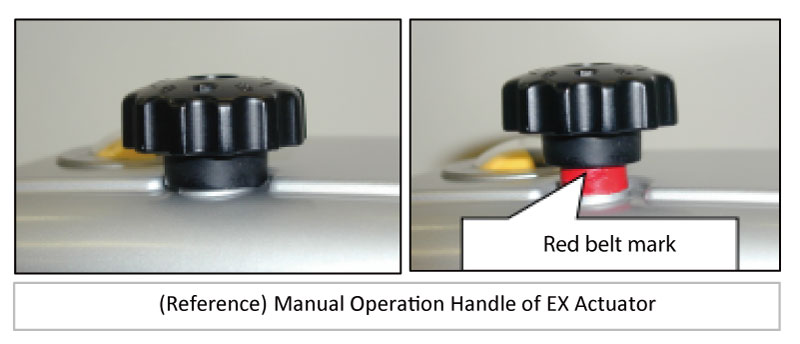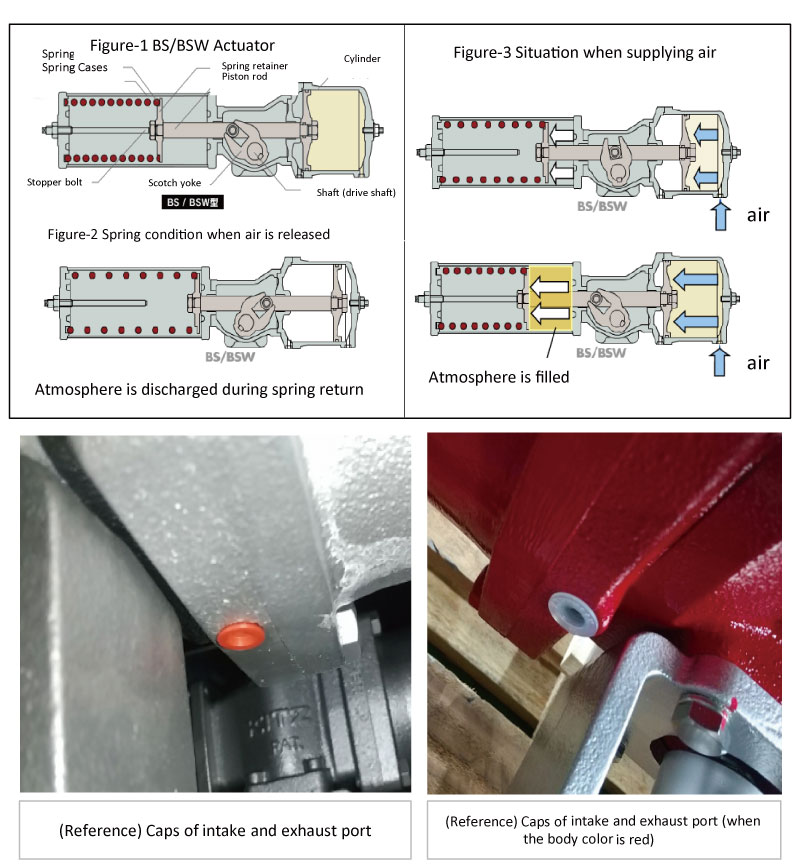Actuator Malfunction Questions
- Electrically Actuated Valves
- The actuator does not start even when power is turned on. (EA Series Actuator)
-
① Check that power is supplied the actuator.
② Check that the electric wires of the actuator are correctly connected to the terminal block and connectors.
③ Check that the connecting part of the crimp terminals is not blocked by the insulation cover of electric wires.
④ Check that the electrical continuity using an electric tester to detect any wiring disconnection.
⑤ Check that the power supply voltage and electrical current value are within the specification range of the actuator.
⑥ If the temperature inside the actuator excess 50°C, the internal components may get damaged or show abnormal operation.
When exposed to direct sunlight, provide a simple sunshade for protection.
Applicable product
- Electrically Actuated Valves
- The actuator does not start even when power is turned on. (EX Series Actuator)
-
Check the manual handle to see if it is not in the pulled-up position.
When the handle is in the pulled-up position, a red belt mark can be seen.
If the handle is in the pulled-up position, push it down until it clicks (or the red mark is hidden).
Applicable product
- Electrically Actuated Valves
- The valve can stick in the fully opened (or fully closed) position. In addition, the actuator generates heat. (EX Series Actuator)
-
① Power may be supplied from both the valve opening and closing circuits to the actuator simultaneously.
Use an electrical tester and confirm that the two opposite electric circuits are not energized at the same time.② Check whether the opening and closing operations of the valve are not frequent.
If the opening and closing operations are frequent, set the duty factor to 30% or less.
As a guideline, ensure downtime of about 2.5 times or more of the opening and closing time.
Applicable product
- Electrically Actuated Valves
- The opening and closing operations of the valve are repeated. (EX Series Actuator)
-
When the actuator is simultaneously driven in parallel with several other actuators, relays, and pumps with a single toggle switch, the currents between the devices may interfere with each other, causing the valve to repeatedly open and close without turning off the power, or causing the relay to chatter.
Use a relay with multiple contacts and use separate contacts for each device.
Applicable product
- Electrically Actuated Valves
- When switched form the EK, EL Series Actuators to the EX Series Actuators, the actuators do not operate at all. (EX Series Actuator)
-
As opposed to the EK, EL Series Actuators (conventional models) where voltage contacts are used, the EX Series Actuators use no-voltage contacts. Therefore, independent power sources are required to the contacts for actuator operation and position signals separately.
The rated electric current values (the values of the electric currents that flow during operation) are different between the EK, EL Series and EX Series.
In case the EX Series is used in existing facilities where EK, EL Series was used, the electric current may exceed the allowable electric current of the components, such as relays, causing the components to melt and stick to each other due to electric energy during operation, and signal switching may not be possible.
Applicable product
- Pneumatically Actuated Valves
- The valve does not operate. (C Series, B Series Pneumatic Actuators)
-
The supply pressure to the actuator may not be achieved.
Check the source of supply pressure, such as an air compressor, to see if it is working normally or if its capacity is sufficient.
Also, check the piping between the source of supply pressure and the actuator to see if it is not clogged, damaged, or frozen.
Applicable product
- Pneumatically Actuated Valves
- The operation of the BS/BSW actuator is slow.
-
The air supply port of the actuator is clogged.
Or, air in the cylinder may not be exhausted sufficiently because the cap of the intake and exhaust port is still attached.
If the cap is still attached, air may be leaked from the actuator body. Therefore, be sure to remove the cap of the intake and exhaust port before operation.
Applicable product
